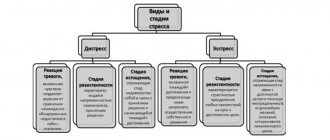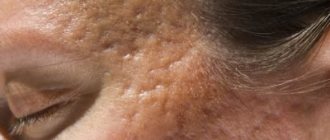Absolutely every person, animal and even the simplest living organism experiences the effects of stress. For a person, both a joyful and a sad event are equally significant factors from the point of view of stress.
In general, there are a lot of terms and definitions of stress.
The very concept of “stress” was introduced in the first half of the twentieth century by the scientist and doctor Hans Selye. He was the first to notice that when exposed to stress factors, there are common response characteristics for most people. It was also Selye who established that when exposed to stress factors, the human body produces a large amount of adrenaline, which was called the stress hormone.
Stress (stress - pressure, pressure (English)) is a set of adaptive and protective reactions of the body in response to any impact (both positive and negative). Selye himself gave the following example as an illustration: a woman who received news of her husband’s death in the war will, of course, experience stress from this sad event. But she will have to endure no less stress if suddenly, many years later, her husband, alive and healthy, appears on the doorstep of the house.
Stress is caused by so-called “stressors” - factors that cause stress, or stress factors.
Stressor (stress factor) is a strong or prolonged impact that leads to stress.
What is stress?
The fact is that stress is nothing more than an adaptive reaction of the body, which, in response to the occurrence of any difficult situation, requires the mobilization of all the forces of the body.
Thus, on the one hand, stress is a danger to the body, and on the other hand, it is a manifestation of its maximum adaptive capabilities. Not only people, but also animals can experience stress. Hans Selye himself, studying stress resistance and the strength of certain stressors, worked with rats, creating for them, as an experiment, unbearable living conditions.
The main provisions of G. Selye’s teaching on stress
The founder of the study of stress, Canadian physiologist Hans Selye, published the results of his original research in 1936.
According to G. Selye, stress is a nonspecific response of an animal body to any stimulus of great strength and duration of exposure (cold, heat, excessive physical activity, mortal danger in the form of a predator, isolation of a herd animal, etc.). Moderate systematic stress increases adaptive properties and reduces the body's emotional reactivity. At the same time, prolonged stress and stress, aggravated by additional stress factors, lead to negative morphofunctional changes in the body, including death.
To model stress, G. Selye used cold as a stress factor, choosing laboratory rats as the object of his observations. 100 animals were placed in a cold chamber in which the air temperature was maintained at about 0 C. The scientist noted that during the first 1-2 days the animals showed signs of anxiety. An autopsy of 10 rats showed that, under the influence of cold, the weight of the thymus decreased in animals and the weight of the adrenal glands slightly increased. However, a more detailed study of the adrenal glands revealed depletion of their cortical layer. The usual fat drops with corticosteroid hormones for this part of the adrenal glands were absent. The rats' stomachs were covered in ulcers.
After 48 hours, the researcher removed 20 more animals from the cold chamber and placed them in another cold chamber, where the ambient temperature was significantly lower than in the first chamber. This group was additionally supplied with rats from a laboratory vivarium, kept at room temperature. The slaughter of rats showed that experimental animals (preliminarily exposed to cold) were unable to withstand a further decrease in the temperature of their environment.
After 5 weeks, some of the rats from the cold chamber with a temperature of 0°C, together with control animals, were moved to a refrigerator with a negative temperature. An autopsy showed that preliminary long-term keeping of rats in a chamber with zero temperature increased the viability of the animals. The mass of their adrenal glands was increased, and gastric ulceration was insignificant.
The experiment with keeping rats at 0°C was continued. But after a few months, the animals began to develop signs of nervous and physical exhaustion, and then the rats began to die. The experiment allowed the scientist to describe the stage-by-stage nature of adaptive changes to cold. Subsequently, it was proven that the reaction of rats to cold described by G. Selye is not a specific response to a cold stimulus, but is of a general nature. The described stage-by-stage reactivity of the animal organism also manifests itself when it is exposed to other stimuli of great strength. Not only laboratory rats, but also other animals respond to stressors in a similar way.
After summarizing the experimental material, G. Selye came to the conclusion that there are 3 stages in the genesis of stress. The first stage - the anxiety stage - develops over several hours (from 6 to 48). This stage is accompanied by the formation of a certain emotional stress in the animal (fear, anxiety, pain, hunger), i.e., an uncomfortable state. At the stage of anxiety, morphofunctional changes occur in the body. The weight of the thymus, spleen, liver, and lymph nodes decreases. There is a change in the leukocyte formula of the blood, in particular eosinophils disappear. The hypothalamic-pituitary-adrenal axis is activated. Under the influence of excitation of the sympathetic system, a large amount of adrenaline is released into the blood, which changes the physiological state of many systems. As a result, animals’ breathing quickens, tachycardia develops, and blood pressure increases.
The hypothalamus increases the secretion of corticotropic hormone, in response to which the pituitary gland increases the release of adenocorticotropic hormone (ACTH) into the blood. In turn, ACTH reaches the adrenal glands through the bloodstream and triggers the release of corticosteroid hormones into the blood.
The second stage - the stage of resistance (or adaptation) - is characterized by the fact that the body mobilizes all its resources to overcome a stressful situation. Corticosteroids prepare various body systems to cope with stress. Against the background of the readiness of the musculoskeletal system for intense work (flight from danger), already under the influence of adrenaline, glucocorticoids stimulate gluconeogenesis and restore the level of glucose in the blood, which was lowered at the first stage due to adrenal pumping. At the second stage of stress, an increase in the mass of the adrenal glands and a high concentration of cortisol and hydrocortisone in the blood of animals are recorded. If the body manages to adapt to the stress factor, then homeostasis is restored and the functioning of all physiological systems is normalized.
When stress is prolonged, a qualitatively new state of the body develops - the third stage of stress, known as the stage of exhaustion. At the third stage, atrophy of the lymphoid system is noted. The proteins that make up white blood cells, plasma proteins, and proteins that form the structures of the lymphatic system are used by the body during the process of gluconeogenesis to synthesize glucose. Multiple damage to the mucous membranes (for example, stomach, duodenum) develops. At the third stage of stress, damage to the lymphatic system is accompanied by a decrease in both general and specific immunity. On this basis, secondary pathologies with an infectious onset arise in animals.
D. Weiss conducted a series of experiments on rats to demonstrate the nervous onset of the ulcerative process in the stomach under stress. The rats were placed in special body-restraining cages.
In two devices, animals simultaneously received an electric shock to the tail. The third rat served as a control and was not exposed to electric current. One of the experimental rats always heard an intermittent sound signal 10 s before the electric shock. The second experimental rat was also notified of the impending painful stimulation by electric current, but the sound signal was not regular and had a random character. A study of the animals showed that the rat, which received regular electric shock alerts, did not develop gastric ulcers. Another rat, for which the shock was always unexpected, had severe stomach ulcerations.
In another experiment, against the background of an audio warning, the rat was given the opportunity to evade the pain factor (climb onto a specially installed platform). It turned out that this ability to evade an unfavorable factor had an even more pronounced protective value. Under such experimental conditions, gastric ulcers did not occur in rats. The experimental results convincingly indicated that the predictability of the stress factor mitigates its negative impact on the animal organism. And the ability to evade its influence through behavioral reactions provides the animal with an adaptive result.
Thus, it has been proven that the psychosomatic reactions of the animal dramatically change the depth of stress.
The stress reaction to an unfavorable factor is not limited to the sympathoadrenal response. A stressor, through the “cortex-thalamus-hypothalamus” channel, stimulates the formation of somatoliberin in the hypothalamus, which enhances the release of growth hormone (GH) by the pituitary gland. Growth hormone counteracts the metabolic effects of insulin, thereby promoting glucose and fatty acid homeostasis in a stressed body. In addition, GH in the development of adaptation syndrome weakens the effect of ACTH on the adrenal glands.
In addition to the noted hormonal processes, the stressor also triggers the thyroid reaction. It looks like this. Under the influence of thyrotropin-releasing hormone from the hypothalamus, the pituitary gland secretes additional amounts of thyroid-stimulating hormone (TSH), which activates the secretory function of the thyroid gland. In turn, the thyroid hormone thyroxine increases the sensitivity of liver and muscle cells to the action of catecholamines, increases the body's basal metabolism (minute volume of pulmonary ventilation, oxygen consumption, heart rate, blood pressure).
Stressful effects on the animal body also affect the neurosecretory activity of a number of brain nuclei. Thus, under stress, due to stimulation of the hypothalamus, the synthesis of β-lipoproteins is activated - precursors of endogenous opiates: dopamine, enkephalin, endorphin, dynorphin. And opiates reduce psychogenic reactivity and increase stress resistance to the effects of adverse factors. Opiates normalize somatic responses to a stress factor, that is, they optimize the animal’s behavior. Ultimately, opiates promote the formation of the resistance stage and counteract the development of the exhaustion stage.
In addition to endogenous opiates, the emotional adaptation of the animal is also influenced by other biochemical and physiological factors, for example the GABAergic system, parasympathetic nuclei, etc.:
- Gamma-aminobutyric acid (GABA) is known as an inhibitory neurotransmitter that can suppress excessive emotional stress reactivity. In addition, in the diencephalon, GABA is converted into gammahydroxybutyric acid (GHB), which also has anti-stress properties;
- prostaglandin PgE is present in brain structures and reduces the sensitivity of nerve cells to catecholamines. In other words, prostaglandin PgE ensures the adequacy of the body's reactions to stressors in the first and second stages of stress;
- the parasympathetic influence of the triple nuclei of the hypothalamus and the vagal lobes of the medulla oblongata stimulates recovery processes and homeostasis constants, which contribute to the development of the resistance stage.
Thus, the adaptation reaction develops under the influence of two opposing systems: a) a system that mobilizes the energy resources of the animal organism to ensure adaptive behavior to the detriment of immune defense; b) a system that limits the depth of the stress reaction and the level of self-harm. The balance of these systems, in turn, is determined, on the one hand, by the modality and strength of the stressor, and on the other hand, by the individual emotional and stress resistance of a particular animal.
If you find an error, please select a piece of text and press Ctrl+Enter.
Causes
There are two main types of stressors (R. Lazarus): mental (emotional) and physiological.
- Mental stressors are a feeling of threat, danger, novelty, the need to solve an overwhelming and complex task, the need for risk, a sudden event, resentment, overload (in everyday life this is usually called “nervous stress.”)
- Physiological stressors are those conditions that directly affect the human body and lead to a violation of its integrity, inadequate environmental temperature conditions, pain, and difficulty breathing.
Stages of stress
Hans Selye identified 3 stages of stress development: mobilization, stabilization and exhaustion.
- The mobilization stage is a feeling of anxiety, which causes the body’s defenses to turn on, which normally allows it to increase its resistance to stressors. At this stage, a person is able to cope with stress, functioning in the usual way and showing practically no outward signs of stress. If the stressor continues to act, then a healthy body carries out a kind of structural “restructuring”.
- The stabilization stage is the moment of consolidation of all the subject’s defense mechanisms in a new quality, at a new level. Outwardly, a person’s behavior may seem unchanged, but in reality, with continued exposure to stress factors, there is an overexpenditure of the reserve forces necessary for adaptation.
- The stage of exhaustion occurs if the source of stress continues to affect the body, and the stressful situation itself continues to persist. In some cases, the outcome of such exposure is a severe deterioration in health, the development of various diseases, or even death.
However, it should be noted that in the presence of the same stressful conditions, the reaction of people (and animals) to stress can be very different.
That is, the characteristics of experiencing stress depend not only on objective, but also on subjective factors:
- assessing a stressful situation, assessing its threat (a pack of dogs running towards them can be perceived by different people in completely different ways);
- experience (an experienced paratrooper and a person making a parachute jump for the first time will also react to this fact differently);
- expectations of the subject (an employee summoned to the boss’s office to receive a bonus, knowing this, will experience less stress than his colleague, to whom the purpose of the invitation to the superior’s office was not explained);
- a person's self-confidence;
- characteristics of the nervous system: for some people, activity in a stressful situation increases, forces are mobilized, functioning efficiency increases, for others passivity and general inhibition occur. However, this feature does not mean that a particular person will always be passive in all stressful situations.
Selye's theory
An interesting experiment on studying stress and its stages of development was conducted by Hans Selye at the Medical Institute. According to his observations, it was clear that any serious disease in humans causes the same symptoms. Why is this happening? He took patients with various complex diseases, mostly fatal ones, and observed the reasons for their development in the body.
An interesting discovery was that almost all patients, before a complex diagnosis, received for a long time an increased dose of adrenaline, which was released in their body. Stress stimulated this release. Therefore, Selye identified the following stages of stress:
- The first stage of stress. A person has a constant feeling of anxiety. All the body's forces are directed to fight this feeling. Normal control over the functioning of organs is lost, and the stomach, intestines, adrenal glands, and immune system are the first to react. According to the scientist’s observations, severe stress can even cause death. Body temperature rises high or drops to critical levels, the body ceases to control the proper functioning of internal organs.
- Second stage of stress. If the body has not received complete exhaustion at the first stage, then the resistance mechanism is activated. Anxiety disappears and natural coping mechanisms are activated.
- The third stage of stress. If professional help has not been organized for a person who suffers from stress, then the third phase may occur. Natural reserves of energy are running out. Anxiety returns and irreversible processes occur in the body. This phase is already irreversible, the physical body gradually ceases to adequately respond to brain impulses, and death occurs.
Modern medicine in the treatment and prevention of stress takes this scientist as the basis for its research, which makes it possible to successfully combat many deadly ailments of the body.
Signs of stress
Signs of stress:
- sleep and appetite disturbances;
- restlessness and anxiety;
- decreased concentration, impaired memory and speed of thinking;
- inability to relax;
- a feeling of melancholy, pessimism, self-pity;
- behavior may become fussy, nail biting, lip biting, and tics appear.
If you notice such changes in yourself or your loved ones, try to consult a doctor as soon as possible. Often it is stress that provokes the development of diseases. Timely seeking help makes it possible to avoid serious health problems.
Dynamics of stress
To determine the most rational ways to influence a person in a stressful situation, it is necessary to have an idea of the dynamics of the development of the state of internal tension (Fig. 8).
There are three stages of stress development:
1) increasing tension or mobilization
(segment AB);
2) adaptation
(segment BC);
3) exhaustion, a decline in internal activity to the background level, and sometimes lower, or disorganization
(segment CO).
Rice. 8. Dynamics of stress
Mobilization (alarm) stage
characterized by an increase in the intensity of reactions, an increase in the clarity of cognitive processes, their acceleration, and the readiness to quickly remember the necessary information.
At this stage, the body functions under great stress, but it copes with the load using superficial or functional mobilization, without deep structural changes.
For example, preparing urgent work for a given deadline, preparing students for exams.
Adaptation stage
(segment BC) appears after the stage of mobilization, provided that stress continues for a long period of time. The optimal level is when the stress experienced is perceived as a positive phenomenon, as a challenge from the situation, but at the same time control over the situation remains with the individual.
This position allows you to achieve a high level of productivity. At this stage, there is a balance in the expenditure of the body’s adaptive reserves. All parameters taken out of balance at the first stage are fixed at a new level.
But if this stage of stress drags on, then the transition to the third stage begins.
Disorganization stage
(segment CO) occurs when the stress load remains stable. At this stage, a violation of the internal regulation of the individual’s behavior may occur, and a loss of control over the situation occurs.
Prolonged stress, even if the individual’s external condition remains unchanged, can lead to serious internal diseases.
The watershed between optimal and excessive levels of stress, beyond which the third stage occurs, is very small and is individual for each person.
It depends on personal characteristics and the individual’s ability to cope with the pressure of the situation.
Some studies have shown a relationship between the type of temperament of managers, the position held and the stress levels of these managers (Table 7).
The studies were carried out at large enterprises of the Russian Federation in 1997. Table. 9.4.1 the sum of the answers is not equal to 100%, since during the survey the remaining respondents did not recognize the fact of stress loads.
Table 7
The influence of temperament on stress in managers
There are a number of reasons that cause individual stress in organizations (Fig. 9). These include organizational, extra-organizational, and personal factors.
Rice. 9 Factors causing personal stress in an organization
Organizational factors that cause stress are determined by the individual's position in the organization. Let's look at examples.
• Labor activity of the individual
– restrictions caused by the regime, shifts of work in the organization, implemented organizational changes, new technologies that the individual has to constantly master.
• Relationships in the organization
– building and maintaining good relationships with your boss, colleagues, and subordinates. This reason is one of the most stressful for workers.
• Not enough
a clear understanding by the employee of his role and place in the production process and team. This situation is caused by the lack of clearly established rights and responsibilities of a specialist, the ambiguity of the task, and the lack of growth prospects.
• Insufficient load
employee, in which the employee is not given the opportunity to fully demonstrate his qualifications.
• The need for simultaneous execution
heterogeneous tasks, unrelated and equally urgent. This reason is typical for middle managers in an organization in the absence of delineation of functions between departments and management levels.
• Non-participation of employees in management
organization, making decisions on the further development of its activities, especially during a period of sharp changes in the directions of work.
This situation is typical for large domestic enterprises, where the personnel management system is not established and ordinary employees are cut off from the decision-making process.
Many Western companies have programs to involve staff in the affairs of the company and develop strategic decisions, especially when it is necessary to increase production volume or improve the quality of manufactured products.
• Career advancement –
the individual reaching a career ceiling or excessively rapid career advancement.
• Physical working conditions
– too high or low temperature in the work area, strong odors, insufficient lighting, increased noise levels.
Extra-organizational factors cause stress as a result of the following circumstances:
•
lack of work or a long search for it;
•
competition in the labor market;
•
the crisis state of the economy of the country and, in particular, the region.
Personal factors that cause stressful conditions are formed under the influence of health status, family problems, emotional instability, low or high self-esteem.
As a result of the above reasons, the following consequences of stress are possible: subjective, behavioral, physiological.
Subjective
the consequences suggest a person’s feelings of restlessness, anxiety, and increased fatigue.
When stress manifests itself in an individual, negative behavioral responses
consequences in the organization in the form of absenteeism, job dissatisfaction, the spread of rumors, gossip.
Physiological
the consequences manifest themselves as increased blood pressure, cardiovascular diseases, sleep disturbances, and apathy.
The losses of organizations from stress are becoming increasingly significant in all industrialized countries.
In the United States, managers consider the causes of stress to be a lack of power, the incompetence of individual managers, and a conflict of trust within organizations.
Japanese managers put stress associated with organizational changes and the need to master new technologies in first place among the causes of stress.
German managers complain about pressure from the increasing pace of work and attribute the stress to insufficient staff training.
All these reasons, as well as the losses of employers caused by employee stress, force organizations to develop stress management programs, work out and implement ways to adapt the individual to the stress load.
Individual stress management
represents ways of adapting the individual to a stressful situation.
There are several levels of stress management.
The first is at the organizational level,
as a result of changes in policy, production structure, development of clear requirements for employees, and assessment of their performance.
Some organizations, mainly foreign companies and some domestic banking structures, conduct relaxation training (after work, 2-3 times a week) under the guidance of a psychologist.
Trainings are also conducted to develop the communicative culture of employees, teach stress relief skills, and on-site game trainings to relieve tension in teams and strengthen connections between employees.
They help a person feel better, relax, and restore strength.
Similar programs exist and are used at the level of the entire organization, especially many of them have been developed at enterprises in Western Europe and the USA.
The second level of stress management is for the individual.
Designed to be able to cope with stress individually, using recommendations and special programs to neutralize stress. Such programs include meditation, training, exercise, diet and sometimes even prayer. They help a person feel better and relax.
•
Learn to manage your
time correctly.
•
Know how
to switch
your activities.
•
Make stress
work for you.
•
Look at the situation from
the outside.
•
Everything passes,
this too will pass.
Let's look at detailed techniques for individual stress management. 1. Learn to manage your time correctly. The ability to properly organize your time is an important means of relieving or preventing stress. Here are some simple rules:
•
When compiling a list of necessary things, list in it, in addition to the necessary ones, those that you would like to do today. By regularly noting what you have accomplished, you get a pleasant feeling of satisfaction;
•
classify all tasks into categories: the main ones and those that can be done later;
It is important to be able to set goals
and
prioritize.
This recommendation, despite its simplicity, is quite difficult to implement: it includes the ability to say “no,” limit oneself, plan one’s activities for each day, taking into account the goal set for a long period;
•
avoid unnecessary promises; this leads to additional stress on the nervous system when you cannot fulfill what you promised;
•
clearly clarify for yourself the difference between activity and productivity:
activity
is a manifestation of external great energy, which does not always benefit the cause;
sometimes it’s fussiness, a lot of movements, but few results; productivity
- fulfilling what was planned, gradually approaching the goal;
•
analyze the reasons for wasting time: long conversations on the phone, waiting in line, doing unplanned things.
There are many technical tools for daily planning of affairs and analysis of time losses: diaries, organizers, office programs for personal computers, etc.
2. Know how to switch your activities.
To get away from stress, it is necessary to find a substitute for the work being performed that is adequate in intensity, another type of activity. This could be another job or physical exercise, sports.
3. Make stress work for you.
If troubles cannot be avoided, then it is advisable to try to derive benefit from them, if possible:
•
try to accept a negative event as a positive one (loss of a job as an opportunity to find a better one);
•
Treat stress as a source of energy.
4. Look at the situation from the outside.
In a calm state, you could not do so much; in an excited state, you managed to do much more:
•
perceive the problem as a challenge;
•
do not think of past events as failure;
•
you cannot be responsible for the actions of other people, you can only control your reaction to them. The main thing is victory over emotions.
5. Everything passes, this too will pass.
•
Try to see the future in a positive light. At least for a moment, remember how you felt when everything was fine.
•
Learn physical relaxation techniques and avoid tense postures that cause stress.
•
If you need to solve a large and complex problem, the mere thought of which makes you give up, break it down into small components and begin to solve them gradually.
•
Do not allow yourself to drown in the pity of others, but do not refuse the help of loved ones.
•
Remember that you are not alone. What you are experiencing now, others have endured and survived. So will it be for you.
Source: https://studopedia.su/1_10365_dinamika-stressa.html
How to cope with stress
You can learn to cope with stress. This is possible on two levels:
- increasing the overall stress resistance of the body;
- organization of special psychological training, development of skills for instant assessment of the situation, emotional-volitional regulation and experience of behavior in specific, stressful conditions.
Thus, a person can be taught to act effectively even in a situation of severe stress, and skills in the field of self-healing can be developed in the event of the onset or threat of the onset of the stage of exhaustion (see above). But if a person, without certain self-help skills, experience, or sufficiently stable functioning of the nervous system, is already experiencing severe stress and is not able to get out of the situation on his own, special professional help is needed.
Since, as we have already noted, various disorders and diseases can result from stress, their timely diagnosis at the earliest stages is very important.
We work with patients whose contact with us was prompted by experiencing stress, taking into account all the necessary components of providing medical and psychological care: diagnosis, prevention, treatment. Our work is to assess the consequences caused to the body by stress factors, eliminate these consequences, and develop self-help skills during stress as a means of subsequent prevention.
Do you need a consultation? Call us now:
The teacher consciously or unconsciously strives for psychological comfort, to reduce the pressure of external circumstances with the help of the means at his disposal. The formation of defense involving emotional burnout occurs against the background of the following phenomena:
1. Symptom of “inadequate selective emotional response.”
The teacher inadequately “saves” on emotions and limits emotional return. The principle “whether I want it or not” applies: if I deem it necessary, I will pay attention to this student or colleague, if I am in the mood, I will respond to his conditions and needs. Despite all the unacceptability of this style of emotional behavior, it is very common. The teacher most often thinks that he is acting in an acceptable way. However, the subject of communication (student) or an outsider (colleague) registers something else – emotional callousness, discourtesy, indifference.
2. Symptom of “emotional and moral disorientation.”
It seems to deepen the inadequate reaction in relations with students. Often a professional has a need for self-justification. Without showing the proper emotional attitude towards the subject, he defends his strategy. At the same time, judgments are heard: “this is not a case to worry about,” “such students do not deserve a good attitude,” “one cannot sympathize with such people,” “why should I worry about everyone.”
3. Symptom of “expanding the sphere of saving emotions.”
Such evidence of emotional burnout occurs when this form of protection is carried out outside the professional field - in communication with family, friends and acquaintances. At work, the teacher still adheres to standards and responsibilities, but at home he withdraws, not wanting to communicate with loved ones.
4. Symptom of “reduction of professional responsibilities.”
The term reduction means simplification. In a professional teacher, reduction manifests itself in attempts to ease or reduce responsibilities that require emotional costs.
The "exhaustion" phase.
It is characterized by a more or less pronounced drop in overall energy tone and weakening of the nervous system. Emotional defense in the form of “burnout” becomes an integral attribute of the individual.
1. Symptom of “emotional deficit”.
The teacher begins to feel that emotionally he can no longer interact productively with students. He turns out to be unable to enter into their position, sympathize and empathize, respond to situations that should touch him, motivate him, and strengthen his intellectual, volitional and moral output.
2. Symptom of “emotional detachment.”
The teacher completely excludes emotions from the sphere of professional activity. Almost nothing excites him, almost nothing evokes an emotional response - neither positive circumstances nor negative ones.
Reacting without feelings and emotions is the most striking symptom of “burnout.” It indicates a professional deformation of the teacher’s personality and causes damage to the subject of communication.
3. Symptom of “personal detachment or depersonalization.” Appears in a wide range of attitudes and actions of the teacher in the process of communication. First of all, there is a complete or partial loss of interest in the student - the subject of professional action. It is perceived as an inanimate object, as an object for manipulation - something has to be done with it.
4. Symptom of “psychosomatic and psychovegetative disorders.”
As the name suggests, the symptom manifests itself at the level of physical and mental well-being. Usually it is formed by a conditioned reflex connection of a negative nature. Much of what concerns subjects of professional activity (in our case, students) provokes deviations in somatic and mental states. Sometimes even the thought of such subjects or contact with them causes a bad mood, bad associations, insomnia, a feeling of fear, discomfort in the heart, vascular reactions, and exacerbation of chronic diseases.
The numerous manifestations of “burnout” can be reduced to three types.
The first is “simplification”, “attenuation” of emotions, when the severity of feelings and the sweetness of experiences disappear. Everything seems to be fine, but it’s boring and simple at heart. Feelings for the dearest and closest people have weakened. Even your favorite food has become coarse and insipid.
Pages: 1
Specifics of the development of professionally important qualities of a student’s personality Professionally important qualities (PVK) are characteristics of a person that affect the effectiveness of his work in terms of basic characteristics (productivity, reliability, etc.). They are a prerequisite for professional activity and at the same time they themselves are improved and polished in the labor process. Leading elements in the structure of a specialist’s PVC…
Low cognitive activity An indispensable prerequisite for the successful inclusion of a child in educational activities is the presence of a cognitive attitude towards reality. Most children have formed this attitude by the time they start school. Children outgrow the play interests that dominated the preschool period of their development. They begin to realize...
Classical behaviorism of D. Watson The theoretical leader of behaviorism was John Braadus Watson (1878-1958). His scientific biography is instructive in the sense that it shows how the development of an individual researcher reflects the influences that determined the development of the main ideas of the movement as a whole. After defending his doctorate in psychology at the University of Chicago, Watson became a prof...









